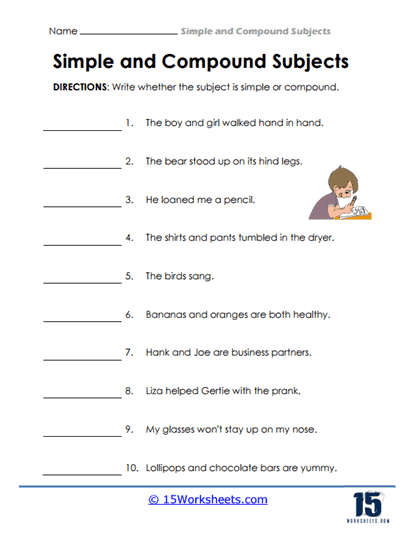

A compound subject occurs when two or more individual subjects are connected by conjunctions like “and”, “or”, or “nor” and share the same verb. For instance, in the sentence, “John and Mary are playing basketball,” “John and Mary” is the compound subject.
These worksheets help students learn how to identify and even use compound subjects to their advantage through a wide variety of means. The exercises on these worksheet include:
Identification – These exercises require the student to identify the compound subject in a given sentence. For instance, in the sentence, “Cats and dogs are common household pets,” the compound subject is “cats and dogs.”
Construction – These exercises ask students to construct their own sentences using compound subjects. They may be given certain words to use or a scenario to write about.
Correction – These exercises involve correcting sentences that improperly use compound subjects.
Conjunction Usage – Students might have to use different conjunctions to combine single subjects into a compound subject.
A compound subject is made up of two or more subjects that are joined together with a coordinating conjunction (like “and”, “or”, “nor”) and that share the same verb. The verb must agree in number with the compound subject, which can make subject-verb agreement a bit challenging when dealing with compound subjects.
Here are examples of compound subjects (in bold):
Cats and dogs are popular pets.
My sister and I are going to the movies.
Either the car or the bike is a good choice for transportation.
Neither the lack of rain nor the high temperatures will ruin our crops.
John, Mary, and Bob are studying for the math test.
In each of these examples, the compound subject is bolded. You’ll notice that the verb (“are”, “is”) agrees with the compound subject. If the compound subject is connected by “and”, the verb is usually plural. If it’s connected by “or” or “nor”, the verb agrees with the subject that is closer to it.